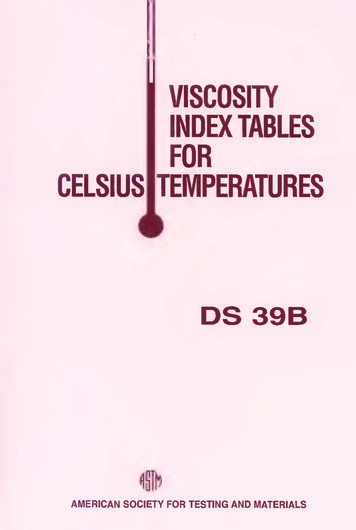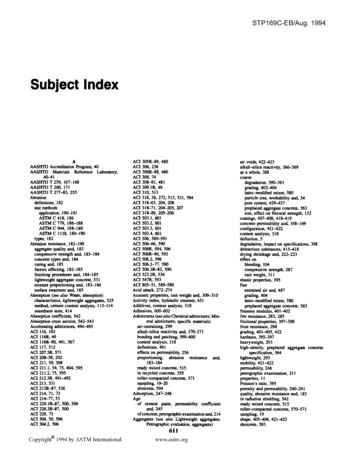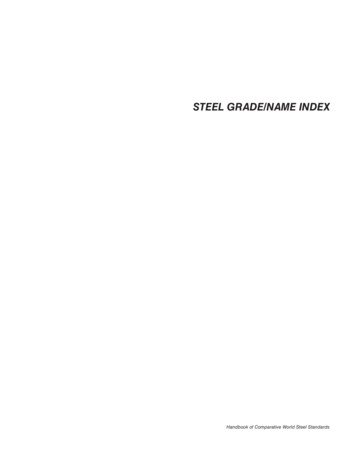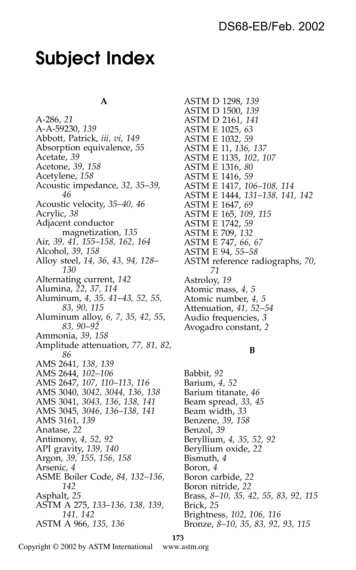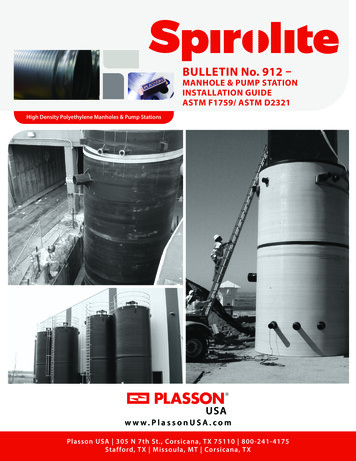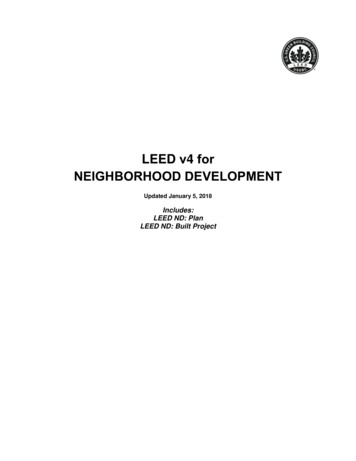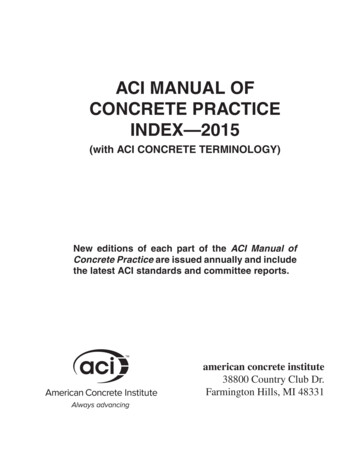![Index [ Astm ]](/img/5/stp37775s-index.jpg)
Transcription
STP169D-EB/May. 2006IndexAAASHTO Accreditation Program, 54AASHTO M148, 469AASHTO M171, 469AASHTO M240, 513AASHTO M302, 513AASHTO Materials Reference Laboratory, 53AASHTO R18, 52AASHTO T199, 62AASHTO T259, 167, 246AASHTO T260, 170, 311AASHTO T277, 246AASHTO T318, 64, 535AASHTO TP 164, 247AASHTO TP 64, 250Abrasion, 184Abrasion resistance, 184–192application of test methods, 191ASTM C 418, 187–188, 190–192ASTM C 779, 187–192ASTM C 944, 190ASTM C 1138, 190–192compressive strength and, 185–186concrete types, 185–186curing and, 187finishing procedures and, 186–187lightweight aggregate concrete, 558mixture proportioning and, 185quality of aggregates and, 184–185roller-compacted concrete, 600surface treatment and, 187Absolute volume method, 346Absorptioncross section, radiation shielding, 573lightweight aggregates, 551–552measurement, accuracy, 353–354tests, 244, 358water, aggregates, 351–352Accelerated curing, 141–149, 471apparatus, 142–143autogenous curing method, 143–144cement chemistry effect, 146experimental program, 141–142high temperature and pressuremethod, 146–147maturity method, 149–152modified boiling method, 143–144results, 142–144testprecision, 145–146procedure significance, 144–145warm water method, 143Accelerating admixtures, 485Acceptable quality level, 22Acceptance plans, 22–23Acceptance testing, aggregates, 17–18ACI 116R, 59–60, 184, 467, 595, 637ACI 121.3R-91, 484ACI 121.4R-93, 484ACI 201.2R, 262ACI 207.5R, 599ACI-209R-92, 202ACI 211.1, 65, 84, 621ACI 211.2, 84, 339, 599, 621ACI 211.3R, 68–69, 599ACI 213, 554, 556ACI 214, 19–20, 28, 63, 80, 82ACI 216, 275ACI 228, 82, 137ACI 228.1R, 319, 324, 328ACI 233R, 513ACI 234R, 219ACI 301, 535ACI 302.1R-04, 184ACI 304R, 65, 592ACI 304.2R-96, 622ACI 306R, 543ACI 308R, 83, 467, 470, 472ACI 308T.G., 471ACI 309.1R, 59ACI 318, 19–20, 51, 261–262, 544,555–556, 620ACI 363, 201ACI 503.1, 627ACI 503.4, 627ACI 506R, 616–617, 619, 622ACI 506.1R-98, 618ACI 506.2, 617, 622ACI 506.3-82, 617ACI 506.4R-94, 623ACI 544.2R, 587ACI 805–51, 616–617647Copyright 2006 by ASTM Internationalwww.astm.orgACI E4-04, 484ACI SP 191, 208Acid attack, 263–265Acoustic shielding properties, 302Activity indexhydraulic cements, 437–438pozzolan, 504slag, 514Additives, content analysis in hardenedconcrete, 311Adhesive materials, epoxy resins,626–628Adiabatic temperature rise, 45–46Admixturesabrasion resistance and, 185alkali-silica reactivity, 407–408chemical composition, 457content analysis in hardenedconcrete, 311definitions, 495drying shrinkage and, 218lightweight aggregate concrete, 553,625polymer-modified concrete andmortar, 608self-consolidating concrete, 639shotcrete, 620see also Air-entraining admixtures;Chemical admixturesAged concrete, petrographicexamination, 210Aggregatesabrasion resistance and, 184–185absorption measurement, accuracy,353–354acceptance testing, 17–18alkali-carbonate rock reactivity, 410ASTM standards, 366batching and measuring materials,539bleeding and, 114–115bulk density, 348–349characteristics, thermal conductivityand, 227–228coarsedegradation, 366–367grading, 339
648TESTS AND PROPERTIES OF CONCRETEAggregates (continued)polymer-modified concrete andmortar, 608with potentially expansive rock,422preplaced aggregate concrete, 592proportions in hardened concrete,383–384size and flexural strength, 134–135workability and, 65coatings, 343, 362–363coefficient of thermal expansion,426–427compatibility with slag, 526compressive strength at hightemperature, 279consistency, 12–13constituents, alkali reactivity, 384content analysis in hardenedconcrete, 311definition, 5deleterious substances, 360–362density, effect, 303dry rodded, 348elastic properties, 371to enhance radiation shieldingattributes, 573–574fineair entrainment and, 478cellular concrete, 562grading, 339–340manufactured, 340pavement wear and, 373polymer-modified concrete andmortar, 608preplaced aggregate concrete, 592proportions in hardened concrete,383–384fineness modulus, 337–338fire resistance and, 277freeze-thaw tests, 369frictional properties, 372–373frost resistance, 290grading, 337–340hardness, 371–372high-density, preplaced aggregateconcrete, 592–593high-strength, 365innocuous, 406–407Micro-Deval test, 369–370microscopic analysis, hardenedconcrete, 388nomenclature, 355–356, 410packing, 347–348particle size distribution, 338permeability, 12, 168physical properties, 346polishing, 372–373pores and pore distribution, 350– 351porosity, 12potential alkali reactivity, 405–406properties, 365–366quarry sampling, 421–422reactive, 404–406reducing field samples to testing size,411relative density, 349–350roller-compacted concrete, 597–598sampling, 411self-consolidating concrete, 639shape, 340–342shape and texture, 347–348shotcrete, 619size, air content measurement and,77soundness, 356–360specifications, 374specific gravity, 12specific heat, 429strength, 12, 127, 370–371structure, 13–14surface moisture, 352–353surface texture, 342–343thermal expansion, 426–427thermal properties, 277, 425–430transition zone, 13unconfined, freeze-thaw testing, 358underwater abrasion test method,368voids, 348–349void space, 13volume fraction and dryingshrinkage, 218water absorption, 351–352wear, 372–373wet degradation and attrition tests,368–370see also Petrographic evaluationAirentrained, factors influencing infresh concrete, 476–480function in fresh and hardenedconcrete, 475–476Air cells, introduction into plasticmixtures, 561Air content, 288–304air-entrained concretes, 73effectof algae in mixing water, 465of hardness in mixing water, 465on density, 304freeze-thaw damage mechanism,289–290fresh fiber-reinforced concrete, 581fresh versus microscopic, 76–77hydraulic cements, 446–447influence on behavior and performance of concrete, 288–289lightweight aggregate concrete, 553measurement, 292effect of surface preparation, 76faulty testing, 78future trends, 79gravimetric method, 77–78pressure air measurement, 75–76sampling, 74significance and use, 73–74volumetric method, 76–77pressure versusgravimetric, 76microscopic, 75ready-mixed concrete, 537–538sequence of material addition and,479supplementary cementitious materials and, 505test, 62test result interpretation, 300Air-entrained concretes, air content, 73Air-entraining admixtures, 291, 474–481classification, 477definitions, 474hydraulic cements, 446materials used as, 474–475ready-mixed concrete, 538recycled concrete, 396roller-compacted concrete, 598self-consolidating concrete, 639status of specifications, 481type and amount, 477–478Air entrainmentfreeze-thaw durability, 73grading effect, 340workability and, 65–66Air-free unit weight test, 61Air voidsdetermination, 480–481dispersion and spacing, 293–294entrained. purposely, 239freeze-thaw damage and, 289–290gradation, 291–292ice formation, 14large, arbitrary deletion, 298shape, 292size and distribution, 476measurement, 292–293spacing factor, 293–294, 475Air-void systemachieving dispersion and small bubble spacing, 290calculation errors, 298effective, 290freeze-thaw durability, 476geometry evaluation, 294–299comparison of fresh and hardenedconcrete, 299image analysis techniques, 298–299linear transverse method, 295–296microscopic analysis, 294modified point-conduct method,296precision and bias, 296–297test methods, 294–296variability and uncertainty,297–298origin and geometric characteristics,290–292polymer-modified concrete andmortar, 609
INDEXready-mixed concrete, 538specific surface, 292–293test result interpretation, 299–300with and without air-entrainingadmixture, 291Algae, in mixing water, 465Alkalicontent, fly ash and natural pozzolan,501–502extraneous sources, 407release, 382Alkali-aggregate reactionsresistance to, lightweight aggregateconcrete, 558structures with, U. S. locations, 387,389Alkali-aggregate reactivity, 108Alkali-carbonate rock reactivity,410–422ASTM standards, 410–411chemical and mineralogicalcomposition, 415compared to alkali-silica reactivity,413concrete microbars, 421concrete prism expansion test,419–420distress manifestations, 411–413expansive dedolomitization reaction,411field service record, 419mechanism of reaction andexpansion, 417petrographic evaluation, 413–415potential, determination by chemicalcomposition, 421quarry sampling, 421–422rock cylinder expansion test, 420–421types, 411using coarse aggregate with potentially expansive rock, 422Alkali-reactive dolomite, 384, 418–419Alkali silica gel, 401–402Alkali-silica reactivity, 401–408admixtures, 407–408aggregate constituents, 384compared to alkali-carbonate rockreactivity, 413controlling, 406–408by admixtures, 487–488fly ash and pozzolan, 505–506gravel and sand, 387hydraulic cements, 447–448identifying potentially reactiveaggregate, 404–406limiting cement alkali level, 407mechanism of reactions and distress,402–404mitigation, slag effect, 520moisture availability and environmental effects, 404safe reactions, 402symptoms, 401–403Alkali sulfates, portland cement, 460Alkali test method, 501–502Aluminum, embedded, 175–177Ambient conditions, effects on curing,470–471American Association for LaboratoryAccreditation, 53–54ANSI A118-4, 614ANSI A118-6, 614Anti-washout admixtures, 488ASI 342, 244ASTM A 185, 620ASTM A 497, 620ASTM A 615, 620ASTM A 616, 620ASTM A 617, 620ASTM A 706, 620ASTM A 767, 620ASTM A 820, 578ASTM C 25, 459ASTM C 29, 348, 350ASTM C 31, 53, 61, 80–81, 84–85,127–128, 136, 151–152, 544,554ASTM C 33, 60–61, 185, 281, 337–343,355, 358, 361, 366, 372, 374, 395,397, 405, 410, 420, 447–448, 515,562, 597, 608, 619, 621, 635–636,639grading, 337–340shape, 340–342surface texture, 342–343ASTM C 39, 46–47, 53, 61, 63, 80,128–129, 131–132, 196, 544ASTM C 40, 26, 28ASTM C 42, 127–128, 131–132, 327,622ASTM C 67, 600ASTM C 70, 60, 253ASTM C 78, 63, 80, 133–135, 196, 279ASTM C 85, 310ASTM C 88, 257, 355–357, 360, 363, 390ASTM C 91, 53, 635ASTM C 94, 19, 60–61, 63–64, 81, 441,462, 533–545, 619, 622aggregates, 539batching plant, 539–540cementitious materials, 538–539chemical admixtures, 539compressive strength testing,543–544control of water addition, 542–543failure to meet strength requirements,544mixing operations, 540–542mixing water, 539sampling, 543ASTM C 109, 32, 36, 46, 437, 444, 457,514ASTM C 114, 311, 451, 457–459, 500ASTM C 115, 292, 436–438ASTM C 117, 53, 343, 380, 614ASTM C 123, 359, 361649ASTM C 125, 5, 59, 65, 292, 339, 383,390, 392, 467, 474, 495, 512,616–617ASTM C 127, 53, 84, 349–353, 358, 551ASTM C 128, 53, 84, 349–353, 358, 551ASTM C 131, 184–185, 359, 362,366–368ASTM C 136, 53, 337, 380ASTM C 138, 53, 62, 77–78, 84, 289,299, 301, 480, 534, 543, 554, 581ASTM C 142, 359, 361, 379, 394ASTM C 143, 40, 59, 61, 66–67, 74, 81,84, 554ASTM C 144, 562, 635ASTM C 150, 53, 118, 219, 221, 234,260, 310, 419, 435, 438–442, 444,446–448, 450–456, 459, 562, 597,607, 619, 635, 639chemical requirements of portlandcement, 453–455ASTM C 151, 219, 221, 437, 442, 444ASTM C 156, 467–469, 471ASTM C 157, 221–222, 420, 437, 439,442, 587ASTM C 171, 620, 622ASTM C 172, 19, 53, 74, 82, 299, 554,579, 581ASTM C 173, 53, 62, 76, 84, 480,553–554, 581, 598ASTM C 177, 227, 280, 430, 564ASTM C 183, 18–19, 26ASTM C 185, 437, 447, 478ASTM C 186, 45, 48, 233, 437, 441–442,457ASTM C 187, 44, 437, 439ASTM C 188, 436–438ASTM C 190, 444ASTM C 191, 43, 88, 437, 441–440, 469ASTM C 192, 80–81, 84–85, 127–128,159ASTM C 204, 292, 436–438ASTM C 206, 503ASTM C 207, 635ASTM C 214, 450ASTM C 215, 46, 155, 157, 200, 315–316,318–319ASTM C 219, 5, 474ASTM C 227, 179, 212, 395, 404–405,437, 439, 444, 447, 457limitations, 405ASTM C 231, 62, 75, 77, 84, 299, 476,480, 537, 553, 581, 598ASTM C 232, 115, 119–121ASTM C 233, 481ASTM C 234, 107ASTM C 235, 361ASTM C 236, 280ASTM C 243, 119–120ASTM C 260, 19, 157–158, 474,480–481, 620, 639ASTM C 265, 446, 448ASTM C 266, 43, 88, 437, 440–442ASTM C 267, 265
650TESTS AND PROPERTIES OF CONCRETEASTM C 270, 632, 635ASTM C 289, 179, 404–405limitations, 405ASTM C 290, 154–157ASTM C 291, 154–155, 157ASTM C 292, 155ASTM C 293, 63, 80, 133–135, 196ASTM C 294, 39, 410, 575ASTM C 295, 39, 208, 215, 359,361–363, 377–378, 380–381,397–398, 404–405, 410–411, 425ASTM C 309, 19, 469–471, 601, 620, 622ASTM C 310, 155ASTM C 311, 18, 437, 497, 499, 501,505–509ASTM C 330, 158, 374, 548–550,556–557, 559, 565, 619ASTM C 331, 549–550, 562ASTM C 332, 549–550, 562ASTM C 341, 221–222ASTM C 348, 444ASTM C 349, 444ASTM C 350, 497–499ASTM C 359, 440ASTM C 360, 67ASTM C 387, 631–632, 634–635packaged, dry, cementitious mixtures,632ASTM C 401, 53ASTM C 402, 498ASTM C 403, 86–88, 90–91, 93–97, 142,441precision, 88–89ASTM C 418, 187–188, 190–192, 366ASTM C 430, 437–438, 503ASTM C 441, 407–408, 439, 447, 505,508, 514ASTM C 451, 437, 440ASTM C 452, 260, 262, 437, 447–448ASTM C 457, 75–76, 79, 239–240, 288,292–300, 310–311, 380, 383–384,390, 398, 476, 480–481, 538methods, 294–296microscopic analysis, 294precision and bias, 296–297ASTM C 464, 316ASTM C 465, 454ASTM C 469, 196–197, 200, 556ASTM C 470, 81ASTM C 490, 155, 232ASTM C 494, 19, 88–89, 157–158, 160,168, 441, 485–489, 562, 598, 623,639ASTM C 495, 565ASTM C 496, 63, 80, 133, 135, 556, 559,565ASTM C 511, 83–84ASTM C 512, 81, 202, 556ASTM C 518, 228ASTM C 535, 359, 362ASTM C 563, 437, 446, 454ASTM C 566, 60, 253ASTM C 567, 301, 303, 548, 554, 559ASTM C 579, 579ASTM C 586, 411, 413, 417–418,420–422ASTM C 595, 53, 234, 435, 437–438,441, 444–448, 456, 513, 515, 517,562, 619, 635, 639blended hydraulic cements, 456ASTM C 596, 221–222, 439ASTM C 597, 199–200, 318, 623ASTM C 617, 129–130ASTM C 618, 114, 232, 260, 407, 442,456–457, 479, 498–500, 504–507,509, 562, 591, 597, 619ASTM C 637, 570, 575, 592, 619ASTM C 638, 570, 575, 592ASTM C 642, 239, 244, 250, 303ASTM C 666, 154–161, 212, 359, 361,480, 557, 600, 610ASTM C 670, 26, 28, 145, 158, 160, 357ASTM C 671, 155–156, 160–161, 359ASTM C 672, 26, 155–156, 161–162,267, 524ASTM C 682, 155–156, 160–162, 359ASTM C 684, 141, 143, 145–147, 152ASTM C 685, 533–534, 536, 543–544,619, 622ASTM C 702, 411ASTM C 778, 444ASTM C 779, 187–192, 366ASTM C 796, 562, 564ASTM C 801, 137ASTM C 802, 26, 28ASTM C 803, 136, 325, 328, 622ASTM C
ASTM C 418, 187–188, 190–192 ASTM C 779, 187–192 ASTM C 944, 190 ASTM C 1138, 190–192 compressive strength and, 185–186 concrete types, 185–186 curing and, 187 finishing procedures and, 186–187 lightweight aggregate concrete, 558 mixture proportioning and, 185 quality of aggregates and, 184–185 roller-compacted concrete, 600 surface treatment and, 187 Absolute volume method .
